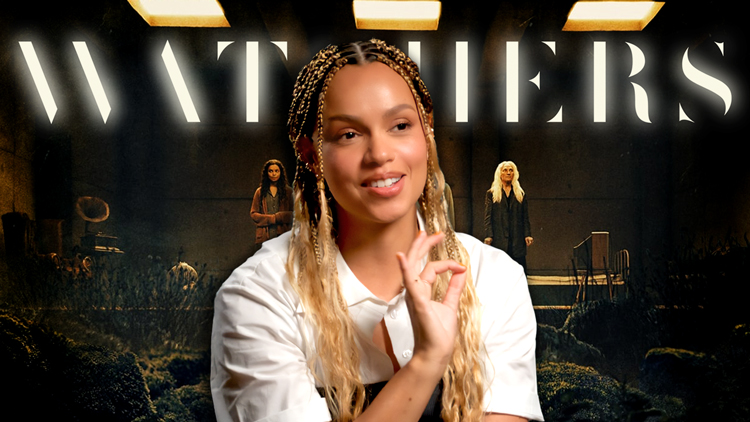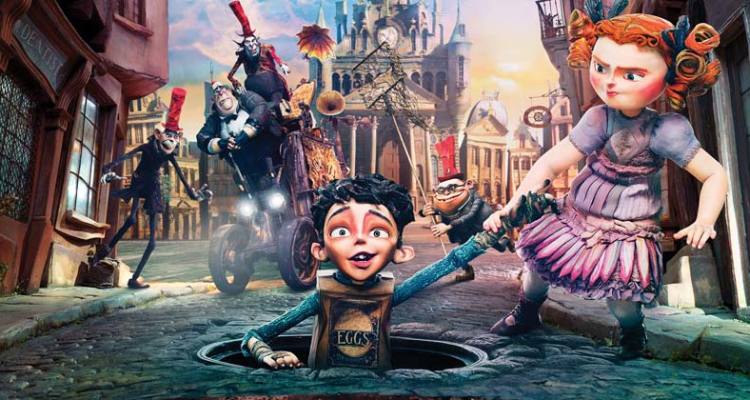DH Movie News was part of a recent press junket in Los Angeles for “The BoxTrolls” (in theaters Sept. 26). Below we have condensed the most interesting remarks by the talented main cast, Elle Fanning, Ben Kingsley, Isaac Hempstead, and the CEO of Laika Studios, Travis Knight.
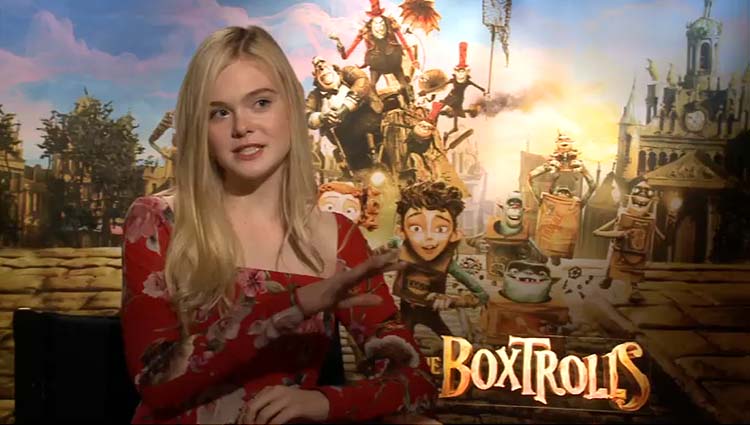
When you first read the script, what stood out to you the most?
ELLE FANNING: I liked that you have to sometimes get into a situation that might not be a comfortable one – so, overcome your fear and good things will happen — if you want someone to know something, or you have to really take charge and do it yourself and go for it. With the Boxtrolls, they want people to know they’re not mean guys, but they’re too scared to show anyone. They have to eventually work up the courage to show that and gain the confidence.
Winnie is very different from most young girls in animated films.
FANNING: She is! I love that. You look at her and you think, “Oh, she looks so cute and sweet.” She has that little Shirley Temple look, but she’s obsessed with these grotesque things – she loves blood – and I liked that opposite. That was fun to play. I feel like audiences at first probably won’t want to like her because she’s a little bratty and spoiled, but then she definitely grows on you and you realize she’s not mean-spirited. She means well. She’s feisty. She has an attitude. I respected her sass. (Laughs) I liked playing that, because I had never really done that before. She is a very different character for me, so it was neat to exaggerate it. It’s funny, because there were a couple drafts of the script where she was a lot meaner. Then they were like, “Maybe we should tone it down and make her a little more likable,” but we kept her snootiness a little bit.
Did you have a chance to see her before you picked the voice?
FANNING: When they sent the script, they sent a big notebook of sketches and the color themes of the movie, and she was sketched in there. She wasn’t completely her final self now, but each time I would go in to do the [voice-over] sessions, they would show me more and more of her progress. It was close to the last session, they finally made her walk. For about two seconds, we saw Winnie walk, and you just have to get inspiration from that. And the animators get inspired by our voices, too, so that helps them. They record our faces while we speak, so some of my facial expressions are in her.
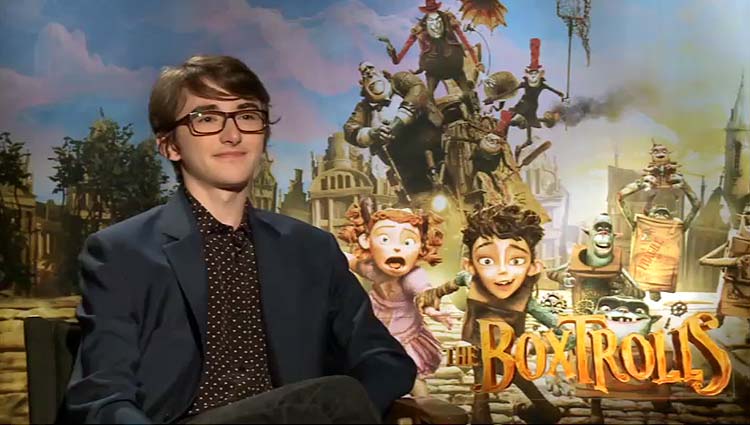
What appealed to you about your character?
ISAAC HEMPSTEAD WRIGHT: I don’t know if I read it and thought, “This is something I really love about Eggs. This is what I’m going to do for my new movie.” It was more just being offered to do a part in the wonderful world of LAIKA that attracted me to it instantly. But I suppose I quite like Egg’s difference from the people he’s been raised by. He’s kind of got the best of both worlds. He’s not all Boxtroll and he’s not all human, because the humans are filled with lunacy in their heads of cheese snobbery and class struggles. And the Boxtrolls, as sweet as they are, are cowards and terrified of everything. He unifies those two elements and creates the Ubermensch, the best superhuman.
When you watched the movie, did you see some of yourself in your character in terms of your hand movements and mannerisms?
WRIGHT: In the nuances? Well, they film you whilst you’re recording and talking, and sometimes they use that as a reference point if there’s anything particular you’ve done which they like. But most of the nuances you’ll see in there are the real actors of the movie, the animators. They’re the ones who make the puppets move and bring them to life. They’re the ones who are thinking, “We need to move the hand like this” and they’ll chat with the directors who’ll say, “We’d like their faces to move up or their arms to go like that.” So they’re the nuances you’ll see rather than me, I think.
How did you find the voice?
WRIGHT: They sent me a little portfolio of the concept art. Every week when I was recording, they’d bring any new art they’d got or any small bits of test footage they’d done. But really the best people for helping me find Eggs and do it were the directors, because they knew Eggs backwards and forwards. They’d spent seven years developing this project, so it was far best to have them explain it than me come up with anything of my own, which wouldn’t be nearly as good. I would really listen to them and exactly how they would think Eggs would be feeling, or what had just been happening prior to that scene or would be happening afterwards, and how this would affect the voice, and how the voice would sound in the first place. It was really down to them.
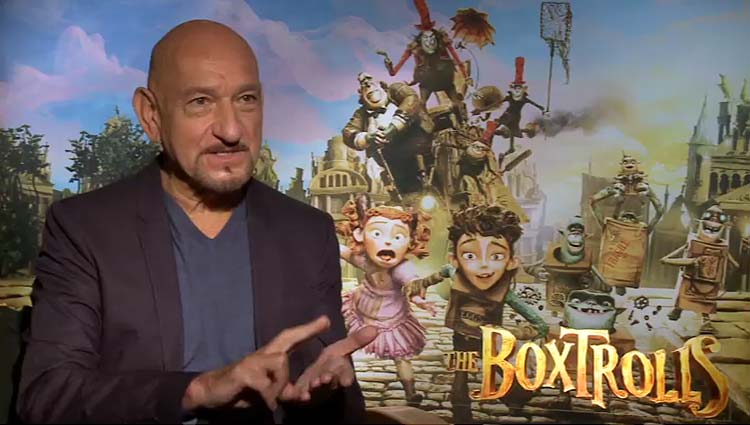
Was it fun to be able to play a character like this that seems so big?
BEN KINGSLEY: I haven’t done much of this before. I was sent the most beautiful script which rang true. It rang true from the honest starting point for a family film, which I think is a very bold, very mature move. Orphans. They go through a struggle. They fight some very dark forces, and they achieve their own light, their own friendship, and their own future. To present this as a family film is very refreshing. I’m sorry to say that I think family films often wipe off the top two generations of the family and say, “Anyone taller than this table won’t like this movie.” That is stupid because it’s not a family film. But this is. It will have resonance for all the members of the family who see it.
I say it’s rooted in truth because I can tell a good script from a bad. My former years as an actor were with tremendously good writers, one in particular. Therefore, the way that this rang true, the way the patterns of human behavior in terms of loneliness, of longing, of care, of nurturing, of loss, of greed, of power, of indifference, they’re all there on the canvas. They’re all beautifully etched. So, it was not a great leap for me to say absolutely yes to the script.
Can you talk a little about your unusual approach to voicing Snatcher and how you found the recording experience?
KINGSLEY: I saw the drawing of the chap and saw that he was physically very different from me. Therefore, my voice would have to come from a different place. I’d have to find a voice that resonated from a very different place and would include all those frailties, those inadequacies, those longings, those addictions, delusions, narcissism and vanity. The guy is a mess held together by an absolute determination to be admitted into a club that does not want him. Because it’s so perfectly written, any actor would recognize that’s the worst thing to do to that guy. The worst thing you can do to that guy is to say, “You can’t come in,” because sooner or later, he’ll smash the door down. And he does. He demonizes a whole tribe of people, who actually have nurtured and looked after an orphan beautifully, who are creative, inventive, loving, and bonded, and they create their own civilization by what upper ground throws away. They never steal. They actually just use what is discarded, and they make their world out of it.
Given that the character is so beautifully presented to me as a portrait artist, my portrayal involved finding a voice that was completely relaxed, not my own. I invited the recording studio to build a kind of airplane seat. It took them five minutes. They had everything in the studio. They had everything there – a reclining chair, something to put my feet on. They were great. Move the microphone, move the script panel, and I did the whole thing reclining, lying down. It also helped me not to make physical gestures. When we speak, we tend to augment our language with our mannerisms. If I did that, it would perhaps lessen or shrink what I was giving the animators. If I had to push something with my physical gesture, it means my voice isn’t doing enough. So, I was completely still, which I found very, very freeing as you say. I didn’t impose many limits on myself other than, of course, the character’s journey and his narrative function in the piece.
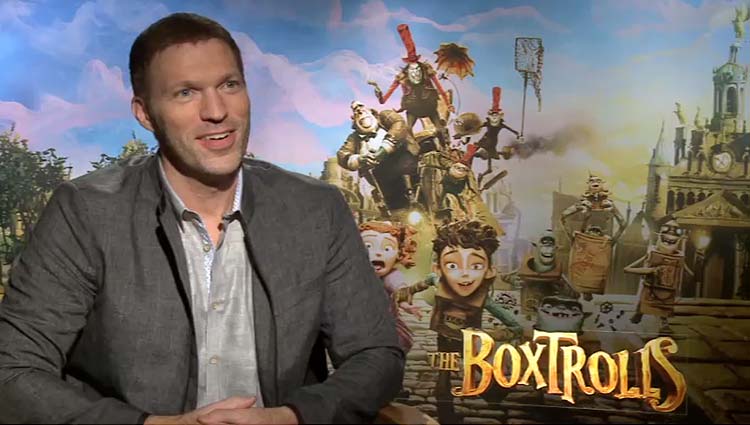
You must have some of the most amazing patience to bring a film like this together frame by frame?
TRAVIS KNIGHT: It certainly takes a special kind of person. It’s funny, I don’t really see it as patience, although you would have to have that on some level just because you’re churning out maybe four or five seconds of footage a week as an animator. I mean, yes, you have to be patient. If it takes you nearly ten years to make a movie, you have to be pretty patient, but I don’t see that as the foundational thing, the most important thing of what we do. For me, it’s less about patience than it is about the ability to focus intensely for long periods of time when you imagine a puppet. I never get bored when I’m animating. While maybe I get through two or three seconds a day, it’s a constant challenge in your head.
It’s almost like a mathematical formula or a chess game. You’re always trying to figure out how you can get your puppet from point A to point B, and so there are all these different little bits. You’ve got to figure out how their arms and legs are moving, what’s going on with the hair, and what’s going on with the eyes. You’ve got to figure all this stuff out and hit your marks, but then it can’t look mechanical. It has to feel alive and look like it’s a real living, breathing thing. And so, it’s mentally very challenging to work through all that kind of stuff. And then, it’s physically demanding too because you’re contorting your body on these sets in all kinds of weird positions, and you’re hurting yourself and bleeding and everything else. So, there’s always something to keep you on your toes. It’s deeply satisfying when all that stuff comes together and you see it come to life in a way that makes it feel like it’s not a doll, but it’s actually a living thing. That’s what we all shoot for – to make these things feel alive.
Can you talk about the conversations you guys had about how scary and intense this could be and how far to push those elements?
KNIGHT: We’re certainly not trying to traumatize any children, and I think we’ve probably failed on that front. When I think about my favorite films growing up, the kinds of films that I loved, the classic Disney films, things like Snow White or Pinocchio, or later, the kinds of films I loved growing up in the 80s like the Amblin films, things like E.T. or Goonies, that kind of thing, they all shared in common this really artful balance of darkness and light, of intensity and warmth. It was a little bit spooky in places where it needed to be, and fun and entertaining in other places, balancing heart and emotion with intensity. For me, that is just good, dynamic storytelling with lots of ups and downs. You can really feel the elation when you’ve gone through a little bit of pain. That was something that defined filmmaking for families for generations. It’s only within the last 25 years that a lot of that stuff has been muted. It’s been tamped down. It’s fine.
Those things are entertaining, but I think they also don’t mean much. When you don’t have a big up and down, where everything is in the-boxtrolls-isaac-hempstead-wright-travis-knightthat drizzly little center, everything is kind of muted. I don’t think you can have much of an experience that gives you much to think about or much to feel. We want to make films that are thought provoking, that are emotionally resonant, that are challenging, enduring and stand the test of time. They’re not little pop culture confections, those little bits of ephemera. And so, that gets to the core of it. Coraline was one kind of film. It was a dark, modern fairytale. Because of that, because of its influences, it had to be scary in places. In ParaNorman, it was this comedic, supernatural thriller, and it was rooted in some of those great Hammer horror films and horror films from the 70s and 80s. And again, because of the inspirations of that story, it had to have some scary elements.
This film is a different kind of a story. It’s our first period piece. It’s kind of an absurdist Dickensian coming-of-age story. It’s a different kind of a story which didn’t necessarily call for scares, but it did have to have some intensity in places. And so, I don’t think Boxtrolls is a scary film, but there are moments that will keep some people on edge and kids in particular. But I also think that’s a good thing. Obviously, we all need to know our children and what they can handle. We make films for families, and we give opportunities for families to connect, and I’m very proud of that. But we don’t make little babysitters, like something you can plop your kid in front of and just turn off their brain and they sit there. We want people to engage in our world.
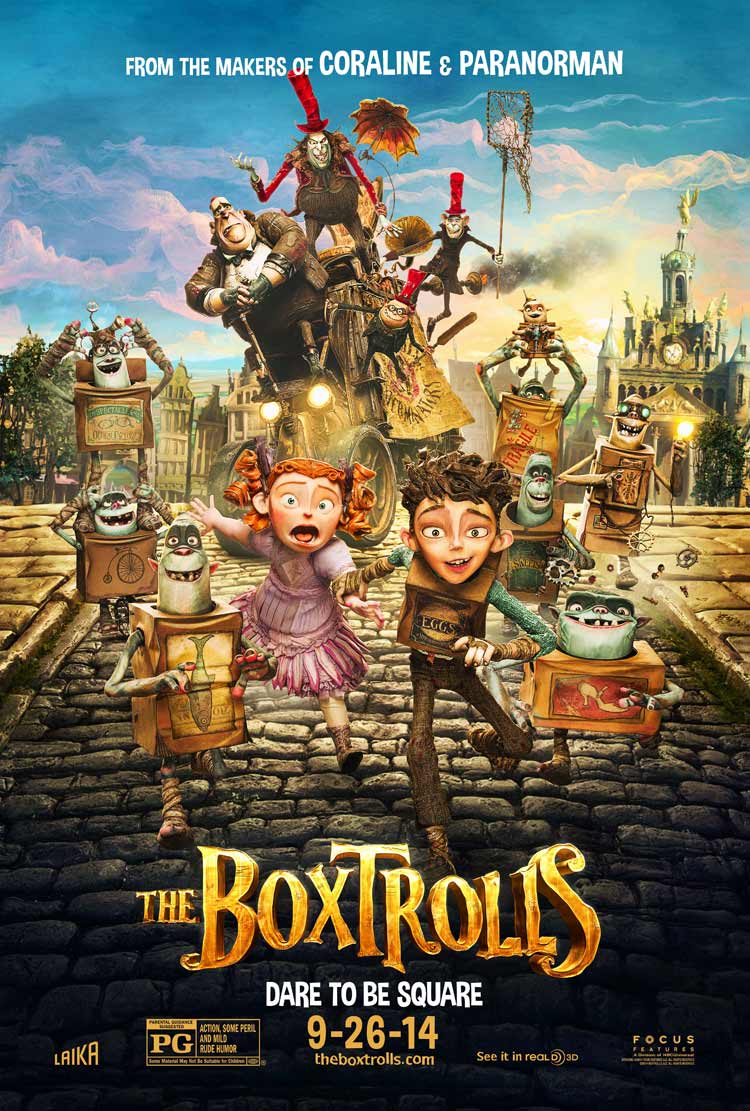
A family event movie from the creators of “Coraline” and “ParaNorman” that introduces audiences to a new breed of family – The Boxtrolls, a community of quirky, mischievous creatures who have lovingly raised an orphaned human boy named Eggs (voiced by Isaac Hempstead-Wright) in the amazing cavernous home they’ve built beneath the streets of Cheesebridge. When the town’s villain, Archibald Snatcher (Academy Award winner Ben Kingsley), comes up with a plot to get rid of the Boxtrolls, Eggs decides to venture above ground, “into the light,” where he meets and teams up with fabulously feisty Winnie (Elle Fanning). Together, they devise a daring plan to save Eggs’ family.




